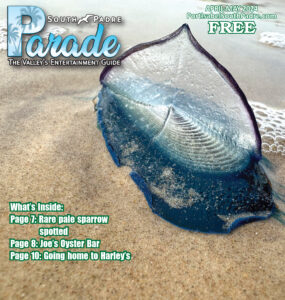By STEVE HATHCOCK
Special to the PRESS
Art and June Magnusson were doing some metal detecting on the flats just north of the Convention Centre when Art’s toe came in contact with a heavy piece of corroded metal. About three inches long and of an unusual shape, the object defied Art and June’s efforts to identify it. Then someone mentioned Steve Hathcock and his column. ‘Bring your beach finds to Steve,’ they were told, ‘and he will probably give you a good guess as to what it is.’
Sure enough, I did.
What Art and June found, was an old brass spike similar to the type used in the construction of the old Spanish galleons. Though it is difficult to put an exact date upon Art’s find, a reasonable person would agree that it is ‘old.’
A galleon’s weight varied from 100 to 1,000 tons. Her armament could include up to 40 guns of various caliber. The ship’s speed, depending on size and shape could be anywhere from 4 to 8 knots.
A medium sized galleon would carry about 100 sailors and passengers. In addition, most carried a contingent of soldiers under the independent command of an army officer. (The wrecks of 1553 near the Mansfield cut were such ships and most of the crew and passengers numbering about 300 survived ) The treasure fleet of 1601 carried 563 men, (excluding passengers) that were scattered amongst six larger galleons.
Building materials, such as oak, cedar, cypress and even olive wood, were chosen locally from the forests surrounding the shipyard. The great forests of Europe were stripped of their taller trees and by the 17th century, the towering fir trees found in the New World were used in the construction of 80 plus foot masts.
Planks for the hull were curved by a variety of methods using water, clamps and open fires to sort of steam the wood into the desired shape. Often as not, the roots were shaped into wooden nails or pegs. (see picture) I have seen pegs that were over three inches in diameter.
The first step in building a ship would be to lay the keel. This was the backbone of the ship and only the finest wood was used. The stem and stern post was next, then the ribs. The ship would now begin to take shape. Often times brass spikes such as shown above were used to nail the decking planks into place. A special caulking material was used to seal the space between.
The super structure was next. Little attention was placed on crews quarters, they were usually rat and flea infested. As a result, the men slept on deck in all but the roughest weather.
The aft and fore structures of the early carracks and galleons, were designed with a military purpose, and literally bristled with gun slits and armament.
The galleons had three masts. The foremast, mainmast, and mizzen mast. The center mast (mainmast) was the tallest and usually carried the most sail. At the top of this mast was small platform called the ‘crow’s nest.’ It was here that lookouts were stationed. From this height sailors would watch for other ships, threatening weather, and land. Crossing the masts horizontally, were wooden beams called yards. It was from these beams that the sails hung from. Rigging, or lines were used to furl and unfurl the sails as needed. A good captain knew how much sail to use in a given moment. Too much sail, and the mast could topple, too little sail and the ship would lose speed. In calm weather, all sails would be run out and wet with water so as to catch even the slightest breeze.
Sails were of a heavy canvas, but could be easily damaged during battle or bad weather. As a result, ships crews included men who could make and repair sails.
The early galleons were top heavy and prone to capsizing. Eventually they went out of production in favor of modern sailing vessels. But every once in awhile, someone like myself or Art and June Magnusson will stumble across a little piece of history and ask ‘What’s this?’
Want the whole story? Pick up a copy of the Port Isabel-South Padre Press, or subscribe to our E-Edition by clicking here.




1 comments
Hello!
Are the triangle and cross on wooden nails typical of any one shipyard? Or was it used all over the place?